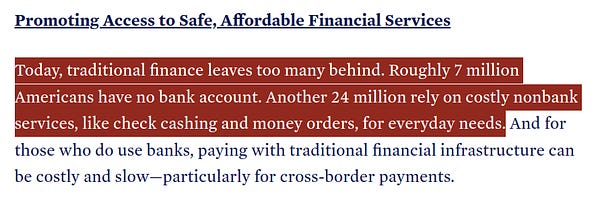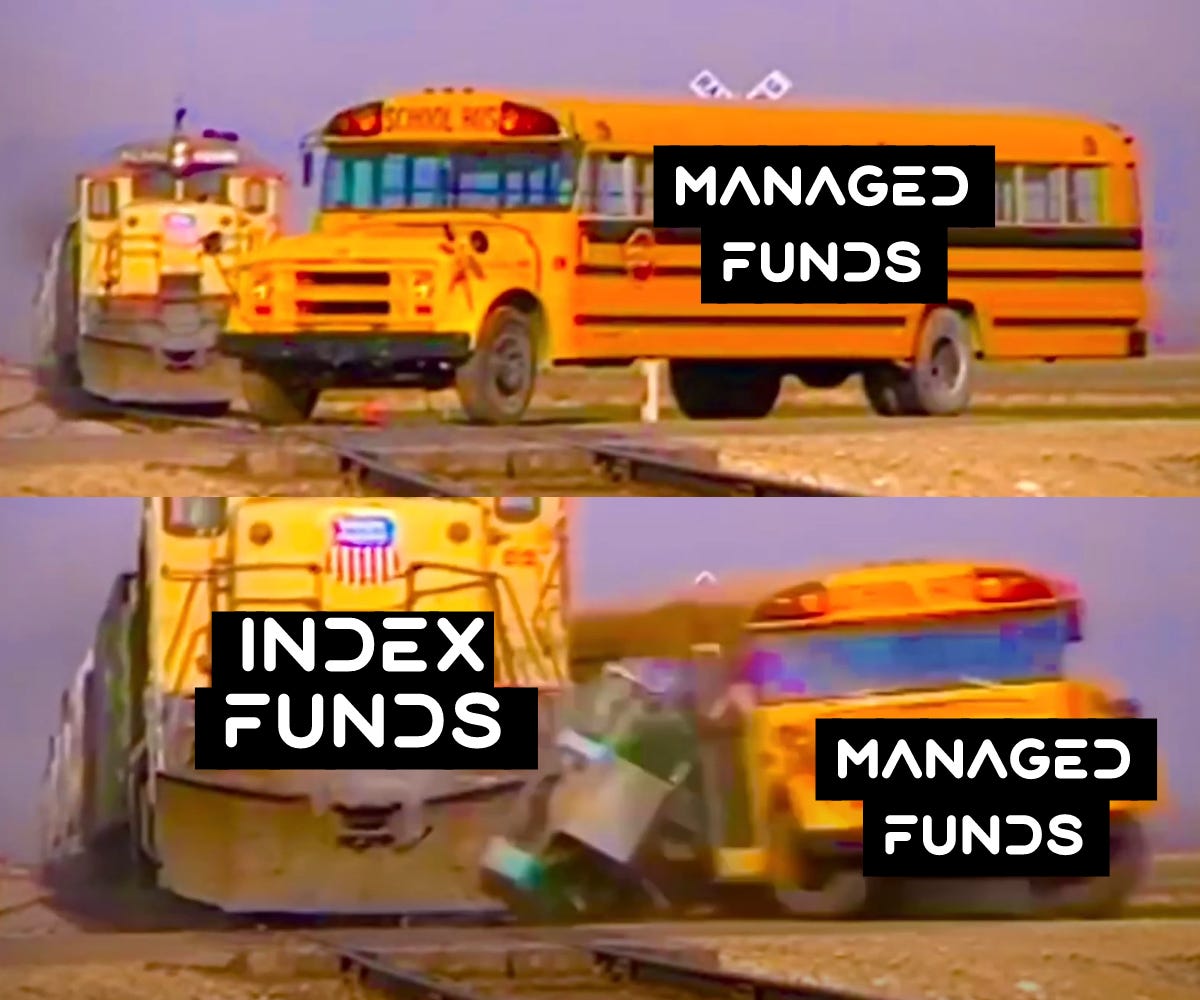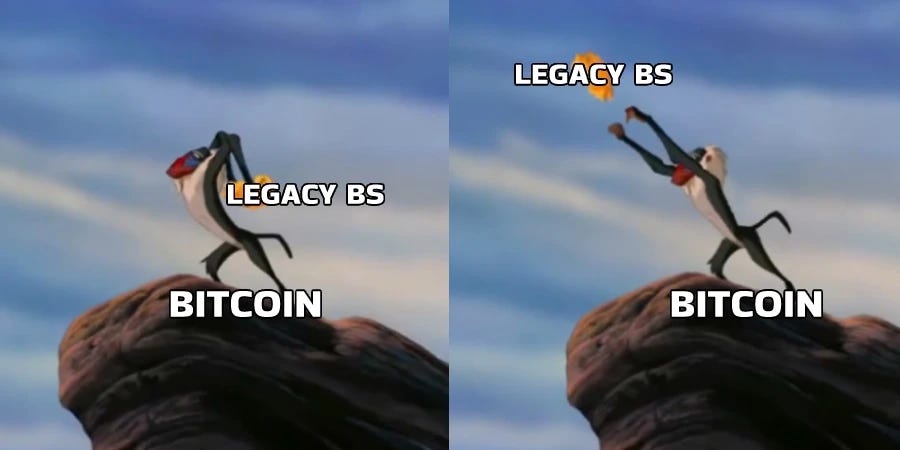You're not imagining it, the absurd wealth inequality in the world is actually getting worse.
Inflation certainly isn’t helping and virtually everyone (including us!) is financially stressed and tired of how corrupt and unfair everything is. Even after being exposed multiple times already via fantastic work like the Panama Papers, there still hasn’t been any significant consequences for the rich.
But how did all these rich people, specifically the “old money” wealth, get rich in the first place? Through investing. What you’ll never hear the experts talk about though is just how much of a walled garden investing is. While they’d like you to believe that “anythings possible!” it’s simply not true when you look at the history of investing.
At least, not in the legacy financial world.
Contents
The Privileged History Of Investing
Investing For Me, Poverty For Thee
Growth Of The Stock Market
Player Two Has Entered The Game
The Bitcoin Value Proposition
The Privileged History Of Investing
Investing has existed for centuries dating back as far as the Venetians in the 1300’s and at every turn only the privileged have been allowed. They’d carry slates around with information on the various issues for sale and meet with clients, similar to what stock brokers do today.
In the 1600’s wealthy individuals would create agreements with sailors similar to how modern limited liability companies (LLC) work today. These agreements would invest in voyages that brought lucrative goods back from India and share the profits. Diversification also existed back then too, as they’d invest in several different ships at the same time in case some of them got rekt… literally!
From this humble beginning, these types of investments limited who could participate because you just had to physically be in the same location back then in order to take part. As such, anyone living outside the main shipping hubs or not in Venice was out of luck.
Secondly, you had to already be privileged enough to have considerable wealth to participate. This was because you couldn’t chop a big investment up into thousands of little pieces like you can today.
For example, a voyage to India to bring back precious cargo might only have 2-3 investors. So even if you’re only investing one third of the total costs, this still ends up being a pretty big amount. As such, investing was exclusively restricted to those top elites that already had considerable wealth on hand, not to mention were in the right place at the right time with the right connections.
Investing For Me, Poverty For Thee
Over time, these shipping companies grew in size and eventually started issuing stocks. Rather than investing in one or two individual voyages, you could now invest in something like the East India Company and it’d pay out dividends from the profits of all of their voyages. As time went on, these stocks (basically fancy bits of paper) ended up getting traded between other investors.
Even though there was no official “stock exchange” at this point, it now meant that you didn’t have to be literally on the docks in order to invest. This opened investing up to more individuals although you still needed to be quite wealthy and also well connected in order to be included in these groups.
In 1773 and 1792 the London and New York stock exchanges were formed respectively and grew into what we currently know today as the general stock market. Throughout their growth, the technology of the time still greatly limited who was able to invest.
The new stock exchange rented a room at 40 Wall Street where the brokers gathered twice a day to trade a list of 30 stocks and bonds.
Practical limitations such as how many people could fit into a room meant that only a certain number of people were allowed to participate. This of course lead to privileged groups of individuals that were allowed to trade and those that were deemed unfit and excluded. Above is an example of how the NYSE operated in 1817.
Growth Of The Stock Market
In 1867 things got a little better again as the invention of the stock ticker made it possible to quickly transmit market updates all across the country. While you still had to be wealthy enough to afford this new technology, it helped to include many new people that weren’t physically there before.
As the market matured further over the decades more people were included as technology got better and cheaper. This enabled more people to metaphorically “sit” in the exchange room but unfortunately, investing was still restricted to the wealthy well into the 1900’s.
Before 1975, many investors used managed funds to invest their wealth which still to this day have very high “minimum investment amounts” meaning you can’t just start with $100. With no computers, it meant that people had to do everything by hand which led to high operational costs that were passed onto the investors in the form of high ongoing fees.
Player Two Has Entered The Game
On December 31st, 1975 John Bogle started the First Index Investment Trust that later went on to become the Vanguard 500 Index Fund. Index funds have grown hugely over the past 40+ years because they did away with much of the active management of managed funds while at the same time performing better. Over this period computers came onto the scene as well, which helped substantially bring down ongoing fees.
In 1999 brokerage firms started to offer fractional shares making the upfront costs even cheaper. While previously you could only buy an entire share, which may have cost $1,000, now you could buy half of it or even 5% of it. This lowered the barrier to enter the investing market, although online brokers still charged $9.99-$24.99 per transaction which isn’t exactly cheap!
Even today, with all our first world technology and privilege you’re still legally limited in what you can invest in. For example, if you want to invest in things like venture capital, hedge funds or an angel investment you have to be an Accredited Investor in the USA. What does that mean practically?
To be an accredited investor, a person must have an annual income exceeding $200,000 ($300,000 for joint income) for the last two years with the expectation of earning the same or a higher income in the current year.
An accredited investor should have a net worth exceeding $1 million, either individually or jointly with a spouse. This amount cannot include a primary residence.
In other words… be privileged and rich.
From the very beginning all the way up to today, every day plebs have been excluded from participating in investing which stops them from being able to effectively grow their wealth. But it’s even worse as we haven’t even talked about the unbanked! Those that don’t have or can’t get basic financial services.
While many talk about the billions of unbanked people in developing countries that are locked out of the financial markets, even the most powerful and rich country on Earth still can’t give basic financial services to their entire population.


While we’ve come a long way in bringing investing to the masses, we’re still not even half way there. Billions of people all around the world don’t have access and never will under the current legacy financial systems.
The Bitcoin Value Proposition
With Bitcoin, the ability to invest or even just have a basic bank account has now been extended to all people worldwide regardless of wealth, location, local laws, career, age, gender, race, religion or anything else.
While you do still need to learn How Bitcoin Works and have at least some form of computer like a mobile phone, all the requirements of $5,000 minimums, being an Accredited Investor, having a government approved ID and so on have been ceremoniously yeeted out the window.
Just download a (free) Bitcoin Wallet, generate your own private keys and buy some Bitcoin from a non-KYC source. You don’t need to ask permission from the government (or anyone). You don’t need a bank account (or any account). You can buy $5 of Bitcoin or you can buy $5,000. You can buy it anywhere there’s Internet or even a cell phone tower in developing countries and on top of all this it’s also more private than legacy investments and gives you better property rights.
Another major value proposition of Bitcoin is that the investment leakage is zero which is frankly astonishing. While most don’t realize it until they buy shares, bonds, real estate or other investments, all legacy investment vehicles leak.
Share brokers usually have monthly fees, index funds have management fees, real estate has ongoing maintenance and potentially real estate agent fees if you use them. These all represent leakage. Costs that you pay for the privilege of maintaining your investment. Costs that just don’t exist with Bitcoin.
>> Learn More: Bitcoin Carrying Costs
You can hold your bitcoins in a wallet for 100 years and pay zero fees. To some this might not sound like a big deal, but when it comes to investing, fees matter a lot! Over 30 years, a 1% fee difference can mean a $140,000+ difference in your balance. While index funding was a game changer that reduced fees, Bitcoin entirely obliterates them. It’s not 1%, it’s not 0.5%. It’s zero. Utterly amazing.
While Bitcoin isn't going to magically fix the huge wealth inequality problems we have in the world, it does strike at one of the core underlying problems that causes it. You're not rich because for all of history the most powerful ways to grow wealth were locked away and only for the privileged.
Now billions of new people are able to have a bank account of their own, can send and receive funds, save and invest for their future.
You don’t have to be born in London to benefit, you don’t have to know the “right person” or have a million dollars or be accepted into an exclusive club to participate. Whether you’re a whale or a pleb, Bitcoin Is Hope for all 8 billion people of the world and now the only thing stopping anyone from investing or saving in it, is simply not knowing how to. So get learning!
Want to get serious about safely and privately using Bitcoin? You need to subscribe now.
Benefits Include:
Read by the top experts, writers, investors and companies in Bitcoin
Learn more about Bitcoin than 99% of people in just one hour a month
Secure your Bitcoin investments and ensure they stay safe from hackers
Know what risks your investments are exposed to and how to fix them
Keep pace with Bitcoins rapid growth and what opportunities it enables
Get insights into how Bitcoin can help your business or work save thousands
Step-by-step guides for all aspects of Bitcoin (wallets, buying and more)
How to do all of these things and maintain your privacy!
NO MORE LOST FUNDS!






